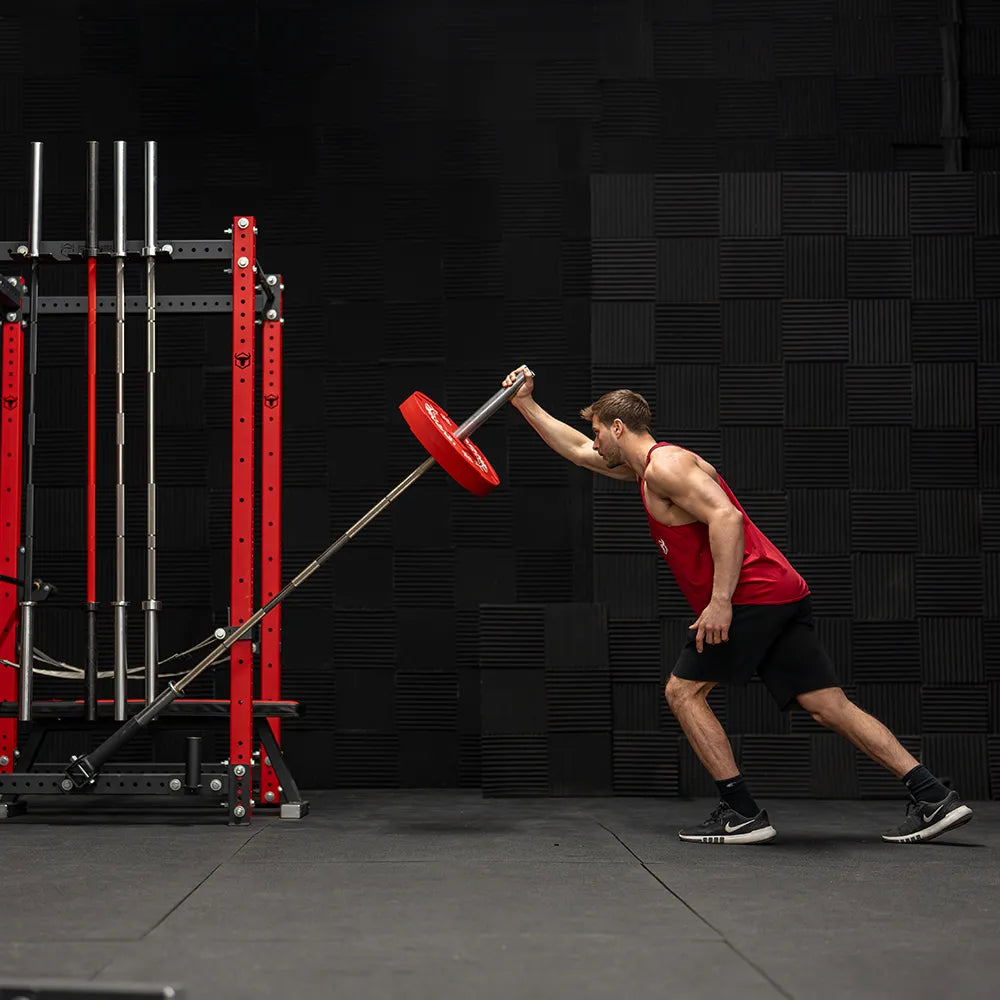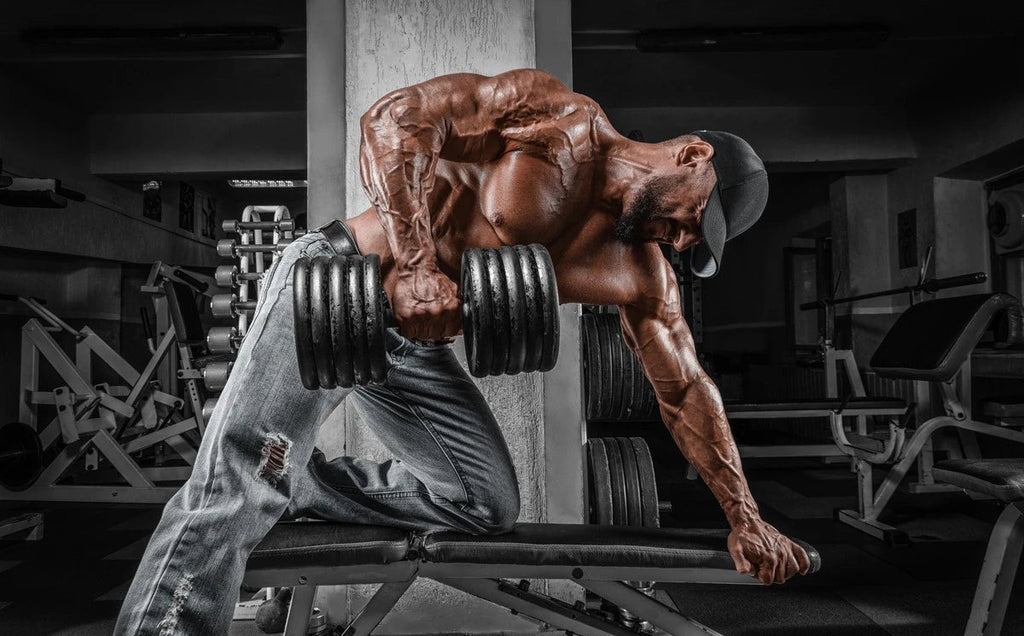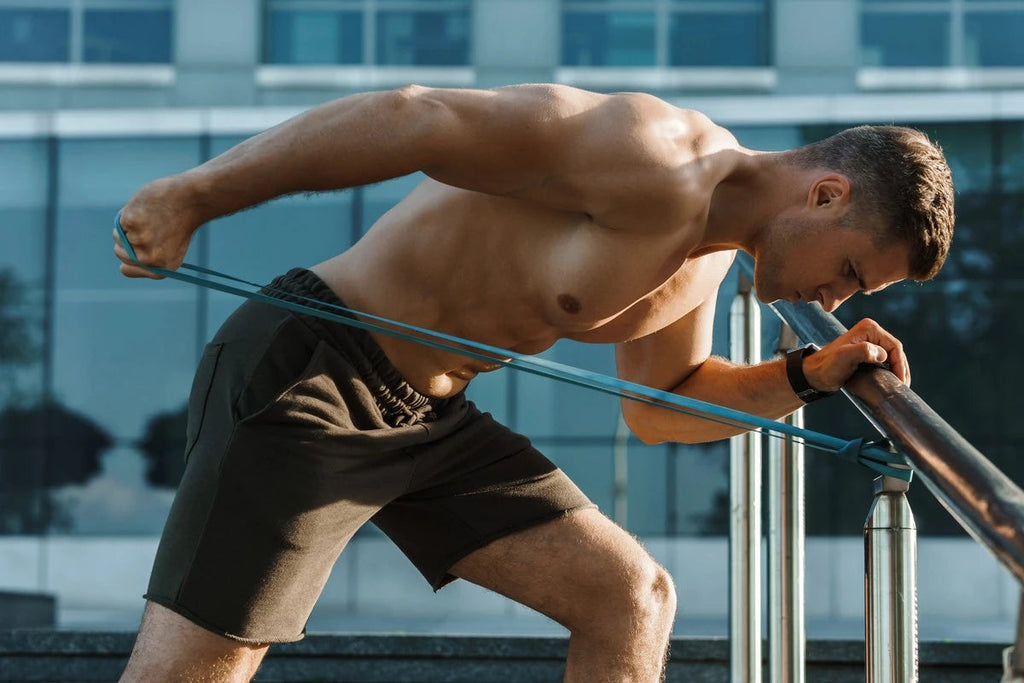Introduction à Landmine Press


Le Landmine Press, un exercice remarquable parmi les squats et les rangées de Landmine, est très efficace et apprécié par de nombreux amateurs de fitness.
En tant que sportif expérimenté, je vous guiderai à travers la bonne technique, vous décrirai les avantages et vous signalerai les erreurs courantes pour cet entraînement polyvalent du haut du corps.
Comment effectuer la presse antimines
Pour effectuer le développé couché, ajoutez vos plaques de poids préférées à la barre .
Tenez-vous face à l'accessoire de la mine terrestre et accroupissez-vous pour saisir la barre avec les deux mains, en entrecroisant vos doigts.
Tenez-vous debout, amenez la barre à hauteur de poitrine, puis relâchez-la avec votre main droite , en la tenant avec votre gauche.
Contractez votre tronc et appuyez sur la barre vers le haut et légèrement vers l'avant jusqu'à ce que votre bras gauche soit complètement étendu , en vous penchant légèrement sur la barre pendant que vous appuyez.
Maintenez brièvement la position, puis revenez lentement à la position de départ. Répétez le nombre de répétitions souhaité avant de passer à l'autre bras.
Conseils d'utilisation de la presse à mines terrestres
Une bonne posture est essentielle pour maximiser les bénéfices du développé couché . Contracter sa ceinture abdominale est essentiel ; une étude publiée dans l'European Journal indique que la contraction des abdominaux augmente la force et la puissance lors des mouvements du tronc.
Cela protège votre colonne vertébrale et améliore vos performances. Veillez à pousser la barre vers le haut et vers l'extérieur, plutôt que verticalement ou horizontalement.
Commencez avec des poids plus légers pour perfectionner ce mouvement avant d’augmenter la charge.
Au plus fort du développé couché, penchez-vous légèrement vers la barre pour obtenir une amplitude de mouvement complète et maintenir la stabilité. Évitez de trop vous pencher en avant, car cet exercice diffère du développé épaules avec barre. Ajustez votre amplitude de mouvement pour trouver celle qui vous convient le mieux.
À quoi sert la presse à mines terrestres ?
Le développé couché sollicite la poitrine, les épaules, le haut du dos, les triceps et le tronc. Il est généralement pratiqué de manière unilatérale, garantissant ainsi un travail équilibré des deux côtés du corps.
Comparé au développé couché, beaucoup trouvent que le développé couché est bénéfique pour la santé de leurs épaules, car vous poussez la barre à un angle plutôt que directement au-dessus de votre tête.
La trajectoire de presse inclinée permet un mouvement plus naturel de l'omoplate , ce que de nombreux haltérophiles trouvent bénéfique.
De plus, le développé couché corrige les déséquilibres musculaires puisqu'il est réalisé unilatéralement. Contrairement à la plupart des exercices pour la poitrine et les épaules, qui sont bilatéraux, cet exercice sollicite les deux côtés du corps de manière égale.
Cela permet de corriger les déséquilibres de force entre les membres. Une pratique régulière du développé couché renforce également la poitrine, les épaules et le tronc, améliorant ainsi les performances dans d'autres exercices comme le développé couché , le développé épaules avec haltères, les élévations latérales et les pompes.
C'est particulièrement vrai pour ceux qui évitent certains développés en raison de douleurs articulaires. Des erreurs courantes peuvent entraver votre progression et augmenter le risque de blessure.
Formulaire d'exercice de presse sur les mines terrestres
Évitez de cambrer le bas du dos pendant la préparation, car cela pourrait fatiguer votre colonne vertébrale. Maintenez une position neutre de la colonne vertébrale tout au long de l'exercice. Le positionnement des coudes est également important ; ne les gardez pas trop près du corps.
Une position confortable et naturelle du coude favorise une meilleure posture et prévient l'inconfort. De plus, évitez le roulis du poignet en saisissant fermement la barre et en la plaçant dans la paume de votre main, le pouce à l'extrémité. Cela permet de maintenir une position neutre du poignet et de réduire les risques de blessure.
Variantes des exercices de mines terrestres
Il existe plusieurs variantes et alternatives à la presse à mines terrestres standard. La presse à mines terrestres à bandes ajoute une bande de résistance pour créer une tension constante tout au long du mouvement. Cette variante peut être réalisée avec ou sans poids supplémentaires.
Squat de mines terrestres
Le squat mine terrestre est un exercice pour le bas du corps qui apporte une nouvelle tournure au mouvement de squat traditionnel.
En tenant l'extrémité d'une barre ancrée dans une mine terrestre à hauteur de poitrine, les haltérophiles peuvent effectuer un squat avec une position du torse plus droite.
Cette variante est particulièrement adaptée aux personnes souffrant de problèmes lombaires ou d'une mobilité réduite des chevilles. Le squat « landmine » sollicite les quadriceps, les ischio-jambiers et les fessiers, tout en sollicitant le tronc et le haut du corps pour plus de stabilité.
C'est un excellent exercice pour développer la force des jambes et améliorer la mécanique générale du squat.
Mine terrestre RDL
Le soulevé de terre roumain (RDL) est un mouvement de charnière de hanche qui cible principalement la chaîne postérieure. Grâce à une configuration « landmine », cette variante du RDL traditionnel offre un angle de résistance unique et une trajectoire de mouvement fixe.
Cela peut être particulièrement bénéfique pour les haltérophiles qui ont du mal à maintenir une forme appropriée dans les RDL conventionnels.
Le Landmine RDL sollicite efficacement les ischio-jambiers, les fessiers et le bas du dos, tout en sollicitant le tronc pour plus de stabilité. C'est un excellent exercice pour développer la mécanique de la charnière de la hanche et améliorer la force globale de la chaîne postérieure.
Presse à épaules Landmine
Le développé épaules Landmine est un exercice qui sollicite principalement les épaules et offre une alternative douce aux développés épaules traditionnels. En exerçant une pression oblique, cet exercice peut être plus confortable pour les personnes souffrant d'un conflit sous-acromial ou d'une mobilité réduite au-dessus de la tête.
Le développé des épaules Landmine peut être effectué de manière unilatérale ou bilatérale, permettant un développement ciblé des épaules et la correction des déséquilibres musculaires.
Cet exercice renforce non seulement la force et la masse des épaules , mais sollicite également le tronc et le haut de la poitrine en tant que muscles stabilisateurs.
Rotations de mines terrestres
Les rotations de mines terrestres sont un exercice de gainage dynamique qui cible les obliques et améliore la force et la stabilité en rotation. Cet exercice consiste à tenir l'extrémité d'une barre ancrée à une mine terrestre et à la faire pivoter latéralement.
Les rotations de mines terrestres sont excellentes pour développer la force fonctionnelle du tronc, car elles imitent les mouvements de torsion du monde réel.
Ils sont particulièrement bénéfiques pour les athlètes pratiquant des sports de rotation comme le golf, le tennis ou le baseball. De plus, cet exercice peut contribuer à améliorer la posture et à réduire le risque de blessures au bas du dos.
Presse pectorale avec mines terrestres
Le développé couché « landmine » est un exercice axé sur les pectoraux qui offre un angle de résistance unique par rapport aux développés couchés traditionnels. Cet exercice peut être réalisé debout ou dans différentes positions au sol, permettant de multiples variations pour cibler différentes zones du torse.
Le développé couché sur mine terrestre est souvent plus doux pour les épaules que le développé couché à plat, ce qui en fait une alternative précieuse pour les personnes souffrant de problèmes d'épaule.
Il sollicite également le tronc et les jambes pour plus de stabilité, offrant un entraînement plus complet du corps que les exercices de poitrine isolés.
Cet exercice est excellent pour développer la force de poussée du haut du corps et la masse musculaire de la poitrine, des épaules et des triceps.
Équipement essentiel pour la fixation de la presse à mines terrestres
Lorsque vous envisagez l'équipement et les accessoires pour la presse à mines terrestres, un accessoire de presse à mines terrestres qui se fixe à un support de squat ou à un support de puissance simplifie l'installation et peut améliorer vos séances d'entraînement avec divers exercices.
Investir dans des disques de poids de qualité est également important, car ils offrent la résistance nécessaire à la progression. Bien que non indispensable, une poignée de presse Landmine peut faciliter la prise en main de la barre et réduire la tension du poignet, offrant ainsi plus de confort et de polyvalence.
Avantages de la presse antimines
La presse à mines terrestres est excellente pour travailler les muscles de la poitrine, des épaules, du haut du dos, des triceps et du tronc.
Il est généralement effectué unilatéralement, ce qui garantit que les deux côtés du corps sont sollicités de manière égale. Beaucoup trouvent le développé couché bien meilleur pour la santé de leurs épaules que le développé couché, car il permet de pousser la barre en biais plutôt qu'en ligne droite au-dessus de la tête.
Presse à mines terrestres vs. presse à suspension
Les principales différences entre le développé épaules Landmine et le développé épaules sont la prise et la trajectoire de la barre. Avec le développé épaules Landmine, vous avez une prise neutre et vous poussez la barre en biais, tandis qu'avec le développé épaules, vous avez une prise en pronation et vous poussez la barre directement vers le haut.
Les personnes ayant des articulations des épaules plus fragiles préfèrent généralement le développé couché. Bien qu'il soit possible de le faire avec les deux mains, il se pratique généralement avec un bras à la fois, ce qui permet de corriger les déséquilibres musculaires de chaque côté du corps.
Intégrer la presse à mines terrestres à votre routine
Intégrer le développé couché à votre programme d'entraînement peut améliorer la force du haut du corps, l'équilibre musculaire et la condition physique générale. Que vous soyez novice en haltérophilie ou athlète expérimenté, cet exercice polyvalent offre des défis et des bienfaits uniques. Commencez avec une posture correcte et des poids légers, puis progressez progressivement.
Maintenez votre tronc engagé et surveillez votre positionnement corporel pour maximiser votre efficacité et réduire les risques de blessures. Explorez différentes variantes pour des entraînements dynamiques et stimulants.
Maximiser les résultats avec la presse à mines terrestres
Même sans accessoire pour mines terrestres, des alternatives comme le développé couché avec kettlebell à un bras peuvent offrir des avantages similaires. La régularité est essentielle. Intégrez le développé couché à vos entraînements du haut du corps une à deux fois par semaine pour des résultats optimaux. Avec le temps, vous constaterez probablement des améliorations en termes de force, de posture et de performances.
En vous concentrant sur la forme, en augmentant progressivement le poids et en essayant différentes versions, vous exploiterez tous les avantages du Landmine Press , contribuant ainsi à vos objectifs de remise en forme.
Écoutez votre corps, restez régulier et développez votre force et votre stabilité avec le développé couché et ses variantes. La persévérance et la pratique vous permettront d'améliorer sensiblement la force du haut de votre corps et vos performances sportives globales.


